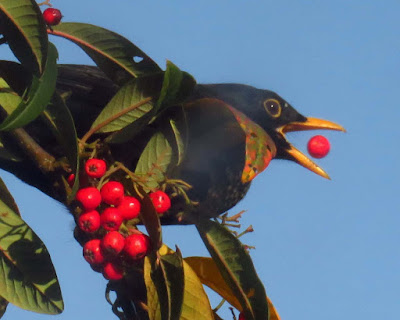After the red squirrel had had enough, it climbed back up the cedar tree and then appeared to cross high over the Firs Chase road. I also heard our neighbours Stephen and Josie Marshall had seen it briefly passing through their garden a couple of days earlier.
There was plenty of sunshine throughout the last day of the year Thursday 31st. Waders and wildfowl enjoyed the grazing fields, made wetter by more rain during the previous night.
An unusual wader on the fields was a ruff which was seen in flight and then walking about near some wigeon. A couple of ruff had also been seen here a fortnight ago but normally they are scarce visitors.
Other birds seen mid morning in the fields were 500+ black-tailed godwits, 130+ lapwing, 300 brent geese, 80 greylag geese, 1000 wigeon and 400+ teal. On the nearby mudflats were 300+ golden plover.
This oystercatcher in the field on Thursday was struggling with its balance and looked very poorly as it kept toppling backwards when it tried to feed. It looked similar to those birds that have suffered from botulism.An unusual wader on the fields was a ruff which was seen in flight and then walking about near some wigeon. A couple of ruff had also been seen here a fortnight ago but normally they are scarce visitors.
Other birds seen mid morning in the fields were 500+ black-tailed godwits, 130+ lapwing, 300 brent geese, 80 greylag geese, 1000 wigeon and 400+ teal. On the nearby mudflats were 300+ golden plover.
This colour-ringed lapwing was first seen and photographed by Andy Field in the grazing fields in late November. We've just found out that this was ringed as a chick on the Berney Marshes RSPB reserve in the Broads near Great Yarmouth, on 26th April 2011. Other than being seen still on Berney 28 days after it was first ringed, it hasn't been seen anywhere else. Here at Cudmore it has been several times during December in the middle of the first grazing field nearest the park.
There are plenty of catkins on the alder trees along from the park pond but this tree seems to be ahead of the game. The mild weather has led to some of the catkins already getting ready to flower turning yellow and opening up.
Two siskin and ten goldfinches were in the alders on Tuesday 29th.
A great tit joined the early spring chorus with its "teacher-teacher" song ringing across the car park on Wednesday. On Thursday a rabbit at the park was suffering from myxomatosis, which seems very unseasonal.
The Sandwich tern was seen at the Strood causeway on Monday by Martin Cock, the third day running it's been seen during the high tide here. Also a barn owl crossed from the island to the mainland near the causeway that afternoon.
Two siskin and ten goldfinches were in the alders on Tuesday 29th.
A great tit joined the early spring chorus with its "teacher-teacher" song ringing across the car park on Wednesday. On Thursday a rabbit at the park was suffering from myxomatosis, which seems very unseasonal.
The Sandwich tern was seen at the Strood causeway on Monday by Martin Cock, the third day running it's been seen during the high tide here. Also a barn owl crossed from the island to the mainland near the causeway that afternoon.


















































